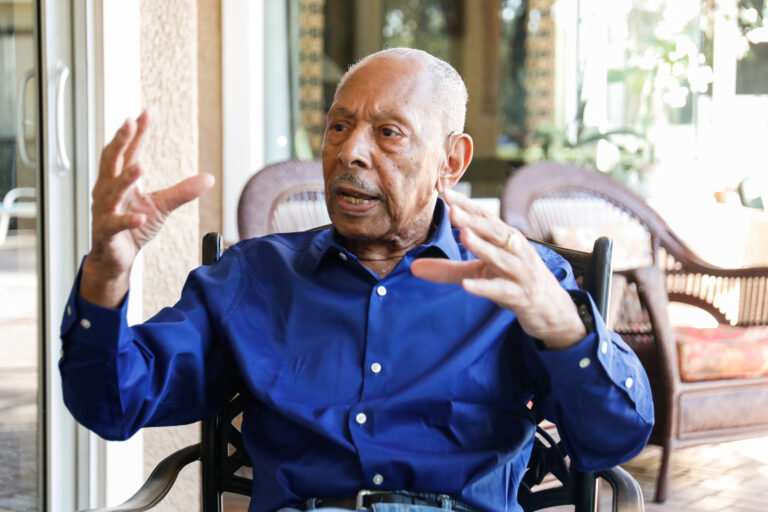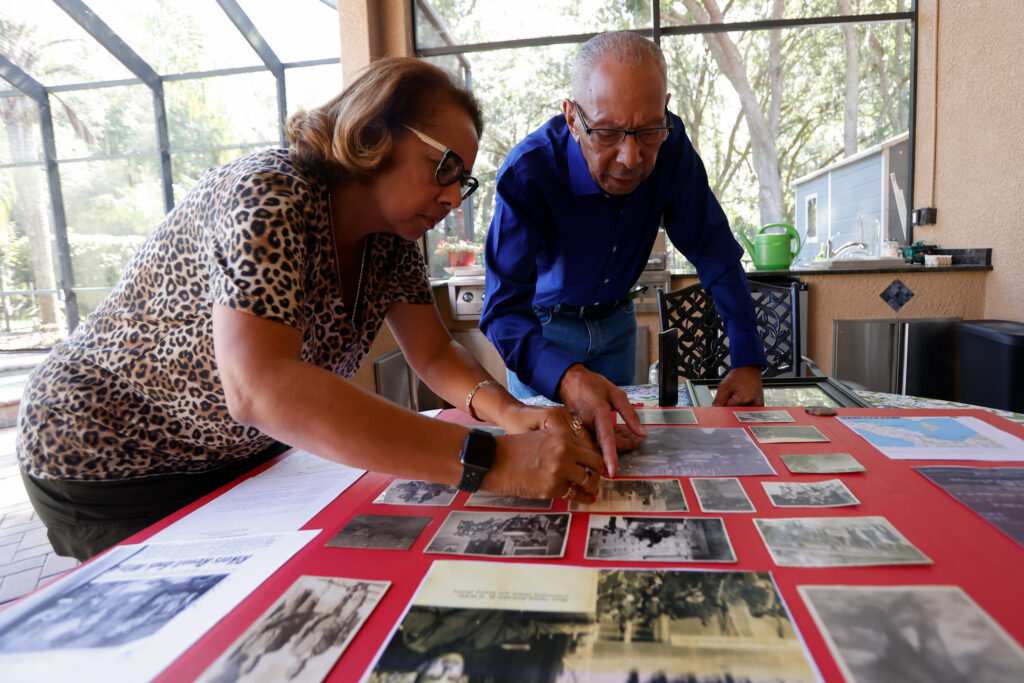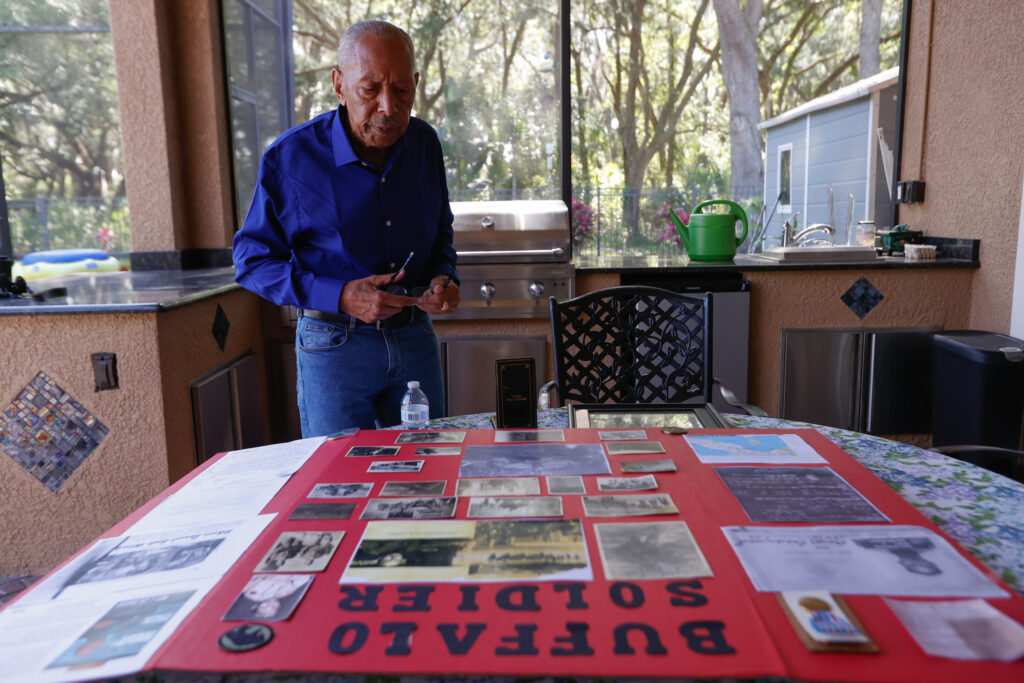
A military police officer at Camp Patrick Henry in Virginia reminded Roy Caldwood of his place in American society during World War II.
“I was sitting in a movie theater on the base,” Caldwood said. “He told me that I had to sit in the last 10 rows.”
Weeks later, for a little while, such treatment was just a memory.
Caldwood, now 100, asked to be transferred to the 92nd Infantry Division of the Buffalo Soldiers, which was the U.S. Army’s all-Black division from the 1860s through 1950s during that time of segregation.
His unit was sent to Italy, where, Caldwood said, he was not treated as a lesser, not even by the Nazis.

“In the United States, I was always reminded that I was Black,” Caldwood said. “Italy was colorless.”
On Wednesday, Tampa City Council will honor Caldwood — who moved to Florida a few years ago to live with his daughter — with a commendation.
He was among those who fought fascism overseas while his life was controlled by Jim Crow laws back home, said City Council member Luis Viera, who proposed the commendation and who represents Caldwood’s New Tampa neighborhood. “Mr. Caldwood’s journey reflects a patriotism that aspires and challenges us to do better and live up to our ideals.”
“He stands as a unique symbol of what is right with our great country,” the commendation reads.

The Buffalo Soldiers were made up of two infantries during World War II. The 93rd served in the Pacific Theater while the 92nd fought in the Italian Campaign.
“I was in that miserable place in Virginia when I read an article in ‘Stars and Stripes’ asking for 14,000 well-trained Black men to join the Buffalo Soldiers,” Caldwood said. “I signed right up. I had been pre-med at Saint John’s University in Minnesota, so they made me a medic in the second platoon made up of 15 men.”
After training at Fort Huachuca in Arizona, the 92nd was sent to Italy during the summer of 1944. Upon arrival, Caldwood figured that he would still be treated as inferior.
“The ugly Americans were already at work,” he said. The white soldiers “were telling the Italians that we were animals who had tails and ate babies.”
But the Italians whom he met did not believe those lies.
“We always needed villagers to provide us with three homes — two for outposts and one for a headquarters,” Caldwood said. “I knocked on the doors to ask because I knew some Italian. They were always happy to have us. We mostly forgot we were Black.”
Serving in northwest Italy, Caldwood estimates that he spent time in 15 villages that had already been liberated by the Allies. His platoon protected residents from Benito Mussolini supporters still in the villages and from Axis troops mounting offensives.
On one occasion, the platoon was ordered to evacuate a village and then to find a location outside of it from where they could repel a pending Nazi attack.
“Before I could leave, two Italians begged me and another medic to help their friend,” Caldwood said. “I looked at my watch. It was very late. The Germans were expected soon. But I had to help.”
He was brought to a man with a fleshless leg. There was no time to ask what happened, Caldwood said. They quickly sterilized and bandaged the leg.
Then, as Caldwood and the other medic tried to leave the village, Indian troops stationed too far away to see the color of their skin mistook the two Buffalo Soldiers for attacking Germans.
“The next thing I know, a mortar is right on top of me, 6 feet away,” Caldwood said. “I put up my arm when it exploded, and I was knocked 30 feet in the air. I thought I was dead. The next thing I know, I open my eyes and I am looking at the sun.”
Besides shrapnel in his arm, he was fine. Caldwood was awarded the Bronze Star for heroic achievement.
Caldwood later thought he was moments from earning a Purple Heart, awarded to those killed or wounded while serving in the military.
A group of Italian women asked for an escort to a grocery store that was a village over. Caldwood and two other men from the platoon volunteered.
“The sun is out and it’s a beautiful day,” Caldwood said. “And then I look around and realize where we were. An area we called ‘Purple Heart Stretch’ because the Germans were hiding in the mountains and killing any American that walked by.”
But no one fired on them. Caldwood later learned that was because the village had a Nazi scout who told the Germans of the mission.
“They respected that we risked our lives to help the women,” he said. “They didn’t see color anymore.”
Mussolini was executed by Italian citizens in April 1945. Caldwood remained in Italy for nearly a year after that. His platoon was celebrated wherever they went.
“In one village, two nuns grabbed us by the hands,” he said. “They took us to a building and opened the doors and all these little kids run to us, jumping and happy. The nuns told me that they wanted the kids to meet the men who made it possible for them to go home.”
Caldwood only worried about his color once while stationed in Italy.
Caldwood’s mother sent a care package that he wanted to share with a lieutenant sergeant and two female friends from the village. As they sat for lunch, word came that a captain was on the way.
“The captain was white,” Caldwood said. “I was suddenly reminded that I was a Black man having lunch with two white women. But when the captain walked in, he just pulled up a chair and asked what was for lunch. There was no discussion of color.”
After the war, Caldwood pursued a career with the New York City Department of Corrections, rising to the rank of assistant deputy warden and program director at New York’s Rikers Island.
Back in the United States, he said, life was no longer colorless.
“That’s a whole other story,” Caldwood said. “That was another fight.”
___
© 2023 Tampa Bay Times
Distributed by Tribune Content Agency, LLC.
0 comments :
Post a Comment